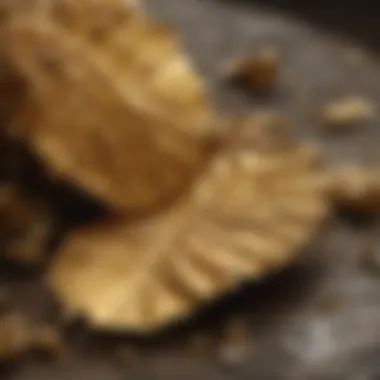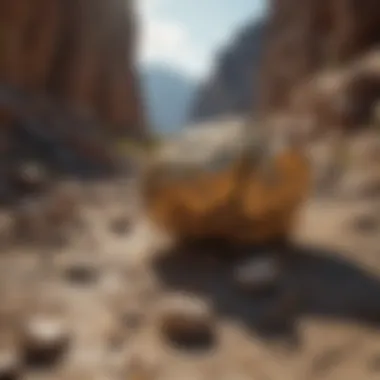Unveiling the Mystery: Exploring the Realm of Gold Nuggets


Rock and Fossil Identification
As we embark on the journey to uncover the mysteries of finding gold nuggets, understanding rock and fossil identification becomes paramount. Different types of rocks and fossils conceal these precious nuggets, each bearing unique characteristics that can guide enthusiasts in their quest. It is essential to familiarize oneself with the diverse types of rocks and fossils found in the targeted locations. By examining the textures, colors, and formations, collectors can enhance their chances of spotting these prized nuggets amidst the rocky terrains and riverbeds.
Collecting Tips and Techniques
Once equipped with knowledge on rock and fossil identification, the next step is mastering the art of collecting. Adopting best practices for collecting can significantly enhance the success rate of finding gold nuggets. From researching and identifying prime collecting sites to employing the appropriate tools for extraction, collectors can maximize their findings. Safety is paramount when extracting specimens, and understanding how to handle equipment and navigate challenging terrains is crucial to a successful hunt.
Preservation and Display
After the thrill of discovery comes the necessity of preservation and display. Techniques for preserving rocks and fossils ensure that the treasures unearthed are protected for future generations to admire. Proper storage methods safeguard the integrity of the specimens, preventing damage or deterioration over time. For enthusiasts who seek to showcase their finds, creative display ideas can transform a collection into a visually captivating exhibit that tells a story of nature's hidden gems.
Geological Insights
Delving deeper into the world of rock and fossil collecting unveils profound geological insights. Understanding the formations and processes that lead to the creation of gold nuggets provides a richer appreciation of these geological treasures. Exploring the historical significance of rocks and fossils sheds light on their role in shaping our understanding of the earth's past. Notable discoveries in the field serve as testament to the endless wonders waiting to be discovered, inspiring collectors to further explore the depths of nature's mysteries.
Exploring Rivers
In this detailed section on exploring rivers for gold nuggets, we delve into the fundamental role rivers play in the quest for this precious metal. Rivers act as natural channels that transport sediment, including gold particles, downstream from mineral-rich regions. Understanding the dynamics of rivers is key to locating areas where gold nuggets might accumulate. By studying the flow patterns, sediment transport, and deposition zones of rivers, prospectors can target prime locations for gold exploration. Exploring rivers offers a strategic advantage due to the repositioning of gold particles through water movement.
Alluvial Deposits
Understanding River Dynamics


Taking a closer look at river dynamics reveals the intricate processes that influence the distribution of alluvial deposits, including gold nuggets. Understanding how rivers meander, erode banks, and deposit sediment sheds light on where gold particles may settle. Factors such as water velocity, turbulence, and gradient shape the movement of sediment, leading to the formation of alluvial deposits in specific areas. The dynamic nature of rivers constantly rearranges sediments, potentially concentrating gold in certain pockets.
Sediment Deposition Zones
Exploring sediment deposition zones within rivers uncovers sites where gold nuggets accumulate over time. These zones serve as natural trap points for heavy particles like gold, which settle as lighter sediments wash away. Identifying sediment deposition zones allows prospectors to focus their efforts on areas with a higher likelihood of gold concentration. By targeting these specific zones, individuals can maximize their chances of discovering valuable nuggets.
Techniques for Gold Panning
Mastering the art of gold panning is essential for effectively extracting nuggets from riverbeds. Utilizing techniques like swirling, tilting, and tapping, prospectors can separate gold from other sediments. The meticulous process of gold panning requires patience and finesse to ensure the retention of precious particles while discarding unwanted material. Implementing specialized tools such as pans, classifiers, and snuffer bottles enhances the efficiency of gold panning, increasing the yield of valuable finds.
Riverbanks and Bars
Erosion Patterns
Observing erosion patterns along riverbanks provides valuable clues to the history of sediment movement and deposition. Erosion exposes underlying layers of sediment, potentially revealing concentrations of gold particles. Studying the patterns of erosion can help prospectors locate areas where gold has been concentrated over time. Understanding how erosion influences the distribution of gold along riverbanks enables more targeted exploration, improving the chances of fruitful discoveries.
Tools for Riverbank Prospecting
Equipping oneself with the right tools is crucial for effective riverbank prospecting. Tools such as metal detectors, crevice tools, and magnifiers aid in the detection and extraction of gold nuggets. Metal detectors assist in locating buried treasure, while crevice tools help reach narrow gaps where gold may be lodged. Magnifiers and tweezers prove invaluable for inspecting and retrieving tiny gold particles. The use of specialized tools enhances the efficiency and accuracy of riverbank prospecting activities.
Tips for Efficient Gold Extraction
Implementing efficient techniques for gold extraction optimizes the recovery of nuggets from riverbank environments. Tips such as working in layers, conserving water, and inspecting crevices meticulously can significantly enhance the productivity of gold prospecting. By strategically planning extraction methods and focusing on high-yield areas, individuals can increase their chances of uncovering valuable gold specimens. Adhering to best practices and fine-tuning extraction strategies leads to more efficient and rewarding gold extraction experiences.


Venturing into Mountains
In this insightful section, we shed light on the crucial endeavor of venturing into mountains in the quest for gold nuggets. As rock and fossil enthusiasts aspire to uncover nature's hidden treasures, exploring mountainous terrains becomes paramount. The rugged mountain landscapes offer a promising opportunity for prospectors seeking a unique gold-hunting experience. The elevated altitudes of mountains harbor secrets of gold veins waiting to be discovered, making this section an indispensable part of our guide.
High-Altitude Prospecting
Formation of Gold Veins
Digging deeper into the intricacies of gold prospecting at high altitudes, we delve into the formation of gold veins. These geological formations play a pivotal role in the distribution of gold deposits in mountainous regions. Understanding the formation process equips prospectors with valuable insights into locating potential hotspots for gold nuggets. The rugged terrain and mineral-rich rocks contribute to the formation of these veins, presenting a fascinating challenge and opportunity for dedicated enthusiasts.
Safety Precautions in Mountainous Terrain
Navigating mountainous terrain requires vigilance and adherence to critical safety precautions. The unpredictable nature of mountain landscapes necessitates robust safety measures to mitigate risks associated with prospecting. From unstable footing to inclement weather conditions, prospectors must prioritize safety to ensure a successful and secure expedition. Implementing safety protocols ensures a rewarding prospecting experience while safeguarding against potential hazards inherent to mountain exploration.
Utilizing Metal Detectors
The utilization of metal detectors revolutionizes the prospecting process in mountainous regions. These innovative tools enhance the efficiency and precision of locating gold deposits amidst challenging terrain. Metal detectors assist prospectors in honing in on metallic signatures indicative of gold presence, offering a technological edge in the hunt for hidden treasures. By integrating metal detectors into their toolkit, enthusiasts elevate their prospecting capabilities and increase the likelihood of discovering valuable gold nuggets.
Navigating Desert Landscapes
Embarking on the journey of navigating desert landscapes is a crucial aspect in the quest for finding gold nuggets. In this section, we delve into the unique challenges and opportunities presented by arid regions, offering valuable insights for rock and fossil enthusiasts seeking to unravel nature's hidden treasures. Exploring desert landscapes not only requires a keen eye for detail but also a deep understanding of the geological makeup of these terrains. Probing into the dry washes and arid regions unveils a wealth of knowledge that can significantly enhance the chances of successful gold extraction.
Dry Washes and Arid Regions


Geological Composition of Deserts
Delving into the geological composition of deserts sheds light on the intricate patterns and formations that influence gold deposition. The arid nature of deserts, characterized by minimal precipitation and high temperatures, plays a crucial role in shaping the distribution of gold nuggets. Understanding the unique mineral compositions and sediment layers prevalent in deserts is essential for devising effective prospecting strategies. The challenges posed by the harsh desert environment are offset by the untapped potential that lies within these arid regions, making them a compelling choice for gold hunting enthusiasts.
Dry Washing Techniques
Exploring dry washing techniques unveils a set of specialized methods tailored for extracting gold from arid landscapes. The arid conditions of deserts necessitate innovative approaches that mitigate the lack of water resources typically used in traditional mining processes. Dry washing techniques leverage air flow and vibration to separate gold particles from the surrounding materials efficiently. These techniques offer a sustainable and low-impact way of prospecting in desert environments, enhancing the overall efficacy of gold extraction endeavors.
Factors Influencing Nugget Distribution
Examining the factors influencing nugget distribution unravels the intricate dynamics governing the presence of gold in desert landscapes. From geological formations to climatic shifts, a myriad of factors influences the dispersion and concentration of gold nuggets in arid regions. By dissecting these influencing factors, prospectors can refine their exploration strategies and target high-yield areas with precision. Despite the challenges posed by the arid nature of deserts, understanding the key factors shaping nugget distribution empowers enthusiasts to optimize their prospecting efforts effectively.
Prospecting in Dune Fields
Wind Patterns and Gold Concentration
Analyzing wind patterns and their impact on gold concentration reveals a nuanced relationship that can guide prospecting endeavors in dune fields. The directional flow of winds carries particles of varying densities, leading to distinctive patterns of gold deposition in sandy terrains. By deciphering these wind patterns and their effects on gold concentration, prospectors can identify optimal locations for extraction and maximize their chances of discovering significant nuggets. Leveraging wind patterns as a natural indicator of gold presence offers a strategic advantage in prospecting within dune fields.
Shifting Sands and Potential Discoveries
Exploring the dynamics of shifting sands uncovers a dynamic environment where potential gold discoveries await keen-eyed prospectors. The mobility of sand dunes creates a dynamic landscape where gold nuggets are transported and redeposited, presenting opportunities for unexpected findings. Understanding the interplay between shifting sands and gold concentration is crucial for adapting prospecting strategies to the ever-changing terrain of dune fields. Despite the inherent challenges posed by sand movement, prospectors who grasp the dynamics of shifting sands stand to unearth remarkable discoveries in these intriguing landscapes.
Using Geomorphology for Gold Detection
Utilizing geomorphology for gold detection offers a strategic approach to prospecting in dune fields, leveraging the natural landscape features to pinpoint potential gold-rich areas. Geomorphological analysis enables prospectors to identify subtle geological indicators that signify the presence of gold deposits beneath the surface. By integrating geomorphological insights into their prospecting methodology, enthusiasts can navigate dune fields with precision and increase the likelihood of uncovering valuable nuggets. The strategic deployment of geomorphological principles enhances the efficiency and efficacy of gold detection efforts in these dynamic and visually captivating landscapes.
Delving into Historical Sites
Delving into Historical Sites offers a unique perspective on the history of gold mining. This section gives us a glimpse into the past, allowing us to trace the roots of this lucrative industry. By exploring these historical sites, we can gain a deeper understanding of how mining techniques have evolved over time and learn from the successes and failures of our predecessors. The significance of Delving into Historical Sites in this article lies in its ability to connect us with our mining heritage, providing valuable insights that can inform our present-day prospecting endeavors. This exploration serves as a tribute to the miners of yesteryears, shedding light on their struggles and triumphs in the quest for precious metals. ### ng Towns and Relics ### ### cin Rush Trails: #### Tracing Gol Trails holds a pivotal role in uncovering the rich history of gold discoveries. This aspect allows us to follow the footsteps of prospectors who once traversed these trails in search of fortune. The key characteristic of Tracing Gold Rush Trails is its ability to provide a roadmap to past gold-rich locations, guiding modern-day miners to potential treasure troves. This trailblazing activity offers a nostalgic journey through time, immersing us in the excitement and fervor of the gold rush era. One unique feature of Tracing Gold Rush Trails is its capacity to unveil hidden stories of perseverance and perseverance in the face of adversities, making it a compelling choice for this article. By delving into these historic trails, we can unearth valuable insights that shape our own prospecting strategies. #### Exploring Abando nes: #### Exploring Abandoned M erves as a window into the past, offering a glimpse into the depths of mining history. This endeavor contributes significantly to our understanding of how mining operations were conducted in bygone eras and the challenges faced by miners. The key characteristic of Exploring Abandoned Mines is its potential to reveal forgotten riches within these derelict spaces. By venturing into these abandoned mines, we can unlock the secrets of past mining techniques and technologies, providing a benchmark for our present-day practices. A unique feature of Exploring Abandoned Mines is the sense of mystery and exploration it evokes, drawing us into a world frozen in time. Preserving Mining Heritage: Preserving Mining Heritage is essential for safeguarding our mining legacy for future generations. This aspect underscores the importance of conserving historical sites and artifacts related to mining activities. By documenting and protecting mining heritage, we ensure that the stories and achievements of past miners are not lost to time. The key characteristic of Preserving Mining Heritage is its role in fostering appreciation for the mining industry's rich history and cultural impact. This preservation effort serves as a testament to the resilience and tenacity of miners throughout history, honoring their contributions to society. A unique feature of Preserving Mining Heritage is its potential to educate and inspire present and future generations about the evolution of mining practices and the significance of sustainable resource management. ### Mineshaft Exploration ### # azards of Mineshaft Prosp g: he Hazards of Mineshaft Prospecting hi t the risks and challenges associated with exploring underground mine shafts. This aspect sheds light on the potential dangers miners may encounter, including cave-ins, toxic gases, and unstable structures. The key characteristic of Hazards of Mineshaft Prospecting is its emphasis on safety protocols and precautions to mitigate these risks efficiently. By understanding the hazards involved, miners can take necessary measures to protect themselves and ensure a safe prospecting experience. One unique feature of Hazards of Mineshaft Prospecting is its capacity to heighten awareness about the importance of proper training and equipment when venturing into mineshafts, making it an indispensable topic for this article. Equipment for Underground Exploration: Equipment for Underground Exploration plays a crucial role in enhancing the efficiency and safety of mining activities in underground environments. This aspect introduces us to a range of specialized tools and gear designed to navigate the challenges of mineshaft exploration effectively. The key characteristic of Equipment for Underground Exploration is its ability to optimize the prospecting process by providing miners with the necessary instruments to detect minerals and navigate through confined spaces. By utilizing advanced equipment, miners can increase their productivity and accuracy in locating valuable deposits underground. A unique feature of Equipment for Underground Exploration is its adaptability to various geological conditions and mining scenarios, offering versatile solutions for diverse prospecting tasks. Strategies for Mine Navigation: Strategies for Mine Navigation offer valuable insights into planning and executing successful underground expeditions. This aspect focuses on the importance of strategizing routes, mapping out mine layouts, and overcoming obstacles in subterranean environments. The key characteristic of Strategies for Mine Navigation is its practical approach to optimizing navigation efficiency and resource allocation underground. By employing strategic techniques, miners can streamline their operations and maximize their chances of discovering valuable resources within mineshafts. One unique feature of Strategies for Mine Navigation is its emphasis on teamwork and coordination among mining teams to tackle complex mine structures and unforeseen challenges effectively. This strategic approach ensures that miners work together seamlessly to achieve their prospecting goals while maintaining safety standards and operational effectiveness.







